Entry Database : PDB / ID : 5kvmTitle Extracellular region of mouse GPR56/ADGRG1 in complex with FN3 monobody (Adhesion G-protein coupled receptor ...) x 2 FN3 monobody alpha5 Keywords / / / / Function / homology Function Domain/homology Component
/ / / / / / / / / / / / / / / / / / / / / / / / / / / / / / / / / / / / / / / / / / / / / / / / / / / / / / / / / / / / Biological species Mus musculus (house mouse)synthetic construct (others) Method / / / Resolution : 2.449 Å Authors Salzman, G.S. / Ding, C. / Koide, S. / Arac, D. Funding support Organization Grant number Country National Institutes of Health/National Institute of General Medical Sciences (NIH/NIGMS) F30-GM116455 National Institutes of Health/National Institute of General Medical Sciences (NIH/NIGMS) U54-GM087519 Brain Research Foundation
Journal : Neuron / Year : 2016Title : Structural Basis for Regulation of GPR56/ADGRG1 by Its Alternatively Spliced Extracellular Domains.Authors : Salzman, G.S. / Ackerman, S.D. / Ding, C. / Koide, A. / Leon, K. / Luo, R. / Stoveken, H.M. / Fernandez, C.G. / Tall, G.G. / Piao, X. / Monk, K.R. / Koide, S. / Arac, D. History Deposition Jul 14, 2016 Deposition site / Processing site Revision 1.0 Sep 28, 2016 Provider / Type Revision 1.1 Sep 27, 2017 Group / Database references / Derived calculationsCategory / pdbx_audit_support / pdbx_struct_oper_listItem / _pdbx_audit_support.funding_organization / _pdbx_struct_oper_list.symmetry_operationRevision 1.2 Apr 18, 2018 Group / Database references / Category / citation_authorItem _citation.journal_id_ISSN / _citation.pdbx_database_id_PubMed ... _citation.journal_id_ISSN / _citation.pdbx_database_id_PubMed / _citation.title / _citation_author.name Revision 1.3 Dec 25, 2019 Group / Category / Item Revision 2.0 Jul 29, 2020 Group Atomic model / Data collection ... Atomic model / Data collection / Derived calculations / Structure summary Category atom_site / chem_comp ... atom_site / chem_comp / entity / pdbx_branch_scheme / pdbx_chem_comp_identifier / pdbx_entity_branch / pdbx_entity_branch_descriptor / pdbx_entity_branch_link / pdbx_entity_branch_list / pdbx_entity_nonpoly / pdbx_nonpoly_scheme / pdbx_struct_assembly_gen / struct_asym / struct_conn / struct_site / struct_site_gen Item _atom_site.B_iso_or_equiv / _atom_site.Cartn_x ... _atom_site.B_iso_or_equiv / _atom_site.Cartn_x / _atom_site.Cartn_y / _atom_site.Cartn_z / _atom_site.auth_asym_id / _atom_site.auth_atom_id / _atom_site.auth_comp_id / _atom_site.auth_seq_id / _atom_site.label_asym_id / _atom_site.label_atom_id / _atom_site.label_comp_id / _atom_site.label_entity_id / _atom_site.type_symbol / _chem_comp.name / _chem_comp.type / _pdbx_struct_assembly_gen.asym_id_list / _struct_conn.pdbx_role / _struct_conn.ptnr1_auth_asym_id / _struct_conn.ptnr1_auth_seq_id / _struct_conn.ptnr1_label_asym_id / _struct_conn.ptnr2_auth_asym_id / _struct_conn.ptnr2_auth_seq_id / _struct_conn.ptnr2_label_asym_id Description / Provider / Type Revision 2.1 Nov 13, 2024 Group Data collection / Database references ... Data collection / Database references / Derived calculations / Structure summary Category chem_comp / chem_comp_atom ... chem_comp / chem_comp_atom / chem_comp_bond / database_2 / pdbx_entry_details / pdbx_modification_feature / struct_conn Item _chem_comp.pdbx_synonyms / _database_2.pdbx_DOI ... _chem_comp.pdbx_synonyms / _database_2.pdbx_DOI / _database_2.pdbx_database_accession / _struct_conn.pdbx_leaving_atom_flag
Show all Show less
 Yorodumi
Yorodumi Open data
Open data Basic information
Basic information Components
Components Keywords
Keywords Function and homology information
Function and homology information
 X-RAY DIFFRACTION /
X-RAY DIFFRACTION /  SYNCHROTRON /
SYNCHROTRON /  SAD / Resolution: 2.449 Å
SAD / Resolution: 2.449 Å  Authors
Authors United States, 3items
United States, 3items  Citation
Citation Journal: Neuron / Year: 2016
Journal: Neuron / Year: 2016 Structure visualization
Structure visualization Molmil
Molmil Jmol/JSmol
Jmol/JSmol Downloads & links
Downloads & links Download
Download 5kvm.cif.gz
5kvm.cif.gz PDBx/mmCIF format
PDBx/mmCIF format pdb5kvm.ent.gz
pdb5kvm.ent.gz PDB format
PDB format 5kvm.json.gz
5kvm.json.gz PDBx/mmJSON format
PDBx/mmJSON format Other downloads
Other downloads 5kvm_validation.pdf.gz
5kvm_validation.pdf.gz wwPDB validaton report
wwPDB validaton report 5kvm_full_validation.pdf.gz
5kvm_full_validation.pdf.gz 5kvm_validation.xml.gz
5kvm_validation.xml.gz 5kvm_validation.cif.gz
5kvm_validation.cif.gz https://data.pdbj.org/pub/pdb/validation_reports/kv/5kvm
https://data.pdbj.org/pub/pdb/validation_reports/kv/5kvm ftp://data.pdbj.org/pub/pdb/validation_reports/kv/5kvm
ftp://data.pdbj.org/pub/pdb/validation_reports/kv/5kvm Links
Links Assembly
Assembly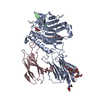
 Components
Components
 Trichoplusia ni (cabbage looper) / References: UniProt: Q8K209
Trichoplusia ni (cabbage looper) / References: UniProt: Q8K209
 Trichoplusia ni (cabbage looper) / References: UniProt: Q8K209
Trichoplusia ni (cabbage looper) / References: UniProt: Q8K209




 X-RAY DIFFRACTION / Number of used crystals: 1
X-RAY DIFFRACTION / Number of used crystals: 1  Sample preparation
Sample preparation SYNCHROTRON / Site:
SYNCHROTRON / Site:  APS
APS  / Beamline: 23-ID-B / Wavelength: 1.033 Å
/ Beamline: 23-ID-B / Wavelength: 1.033 Å Processing
Processing SAD / Resolution: 2.449→46.391 Å / SU ML: 0.38 / Cross valid method: FREE R-VALUE / σ(F): 1.35 / Phase error: 30.66 / Stereochemistry target values: ML
SAD / Resolution: 2.449→46.391 Å / SU ML: 0.38 / Cross valid method: FREE R-VALUE / σ(F): 1.35 / Phase error: 30.66 / Stereochemistry target values: ML Movie
Movie Controller
Controller


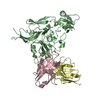
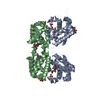
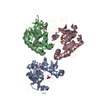
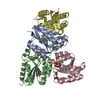

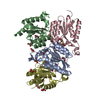
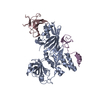

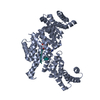

 PDBj
PDBj


